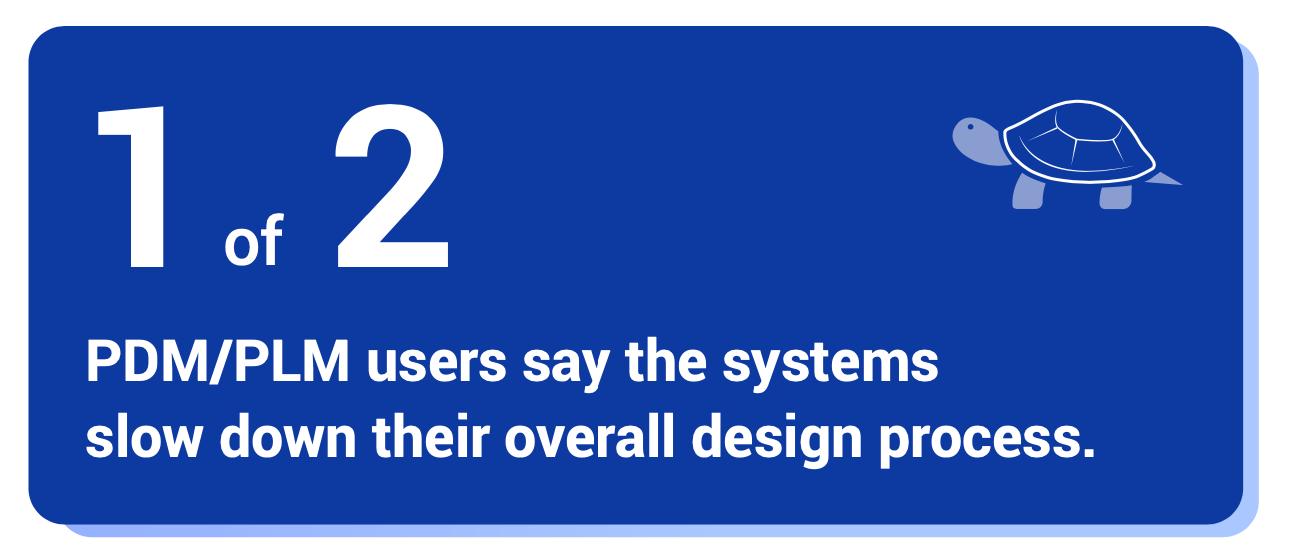
06:31
“What gets measured gets managed.” This phrase from business management guru Peter Drucker expresses a truth that is timeless in its common sense. In order to manage a process or an outcome, a business manager (or a designer or engineer) must have the relevant data. Whether optimizing an assembly line or simply understanding “where things are at” with a product development process, insight into the data is essential.
Product development leaders know the importance of precision and measurement all too well. Often the success or failure of a new product feature – the result of hundreds or even thousands of hours of engineering work – can come down to a difference of millimeters in a precisely fitting design. Given the exacting standards of engineering in nearly every industry, it is troubling that product designers and their project managers have had to labor without any access to real-time data, which is not possible when using file-based CAD and PDM.
Designers and engineers using file-based CAD today must do their work on individual, isolated workstations. In order to share a design file, they must make and send a copy of it to a colleague or external partner. While an engineer works on the file, other team members have no visibility into its current status. And even when a copy is shared, that file version may quickly be outdated as work continues on it at the individual workstation of the engineer. The result can often be a version-control nightmare with multiple copies and different versions of the same design stored in different places.
From a management standpoint, no one truly has visibility into the current status of a design document.
On-premise CAD systems create a dynamic where individual engineers are often working alone on their own downloaded designs. Without cloud-based sharing of a common document, these files are autonomous islands of data confined to each workstation. So if teams can’t even see each other’s data, how are they supposed to distill timely insights from it? Similarly, how can a head of engineering or business manager be expected to ensure deadlines are met and customer deliverables are on track if real-time team data is not available?
The Limitations of File-Based PDM Systems
In response to the universal challenge of version control issues, many product development teams have resorted to add-on product data management (PDM) systems. These systems effectively act as a digital “lock box,” forcing a user to check in and check out a design file. The rote process is intended to ensure there is only one version of a design document. However, file-based PDM systems also enforce serial workflows, as the tedious process of logging in and logging out files requires users to wait for a colleague to finish their work before any new work can be started.

According to The State of Product Development and Hardware Design 2020, an independent industry survey commissioned by Onshape, the engineering world’s frustration with product data management technology is loud and clear. The survey of nearly 1,000 worldwide product development professionals found that more than 50% of file-based PDM/PLM users believe the systems are slowing down their overall design process.
In order to keep on top of all of the data that is not readily available day to day, it is not uncommon for engineering managers to resort to weekly “check ins.” These managers, often at the end of a day on Friday, essentially say to their teams “pencils down,” and ask all engineers to check in their designs at the same time. The manager can then survey the current status of all projects – and only for that brief pause in the 40-hour-plus workweek, he or she can truly understand where things stand.
This synchronization of files seems quaint, almost like an old war movie where the heroes pause, pull on the crown of multiple wristwatches and ensure they are all operating on synchronized time. While this may make for good historical drama, the practice is less desirable for engineering. Productivity grinds to a halt as users must check in their files. Even if an engineer has “momentum” and wants to keep working on their specific task, they are nonetheless forced to break their concentration, stop and turn in their work. The consequences are significant and profoundly negative for productivity and morale.
The analog check-in process reveals a core truth about data management today in product development. The fact is that managers using file-based CAD or PDM systems have very little visibility into the projects that they are supposed to be managing.
Cloud-Based Product Development Tools Provide Anytime Access to Data

In contrast to the challenges created by file-based CAD and add-on PDM software, cloud-based product development solutions enable immediate anytime access to design documents and the confidence that it is the most up-to-date data – a reliable “single source of truth.”
With a cloud-based CAD platform, engineering managers have 24/7 visibility into a project’s status and latest design improvements, reducing the likelihood of last-minute surprises and bottlenecks. Team leaders can identify opportunities to accelerate or optimize existing processes. Resources can be allocated to address the team’s most pressing needs, and projects can be kept on budget and on time.
Using cloud-based CAD with integrated data management means that executives and managers never need to guess about the status of their projects again. In PTC’s Onshape SaaS product development platform, for example, real-time business analytics show managers how many hours were spent by each team member so future work can be planned accordingly.
By providing data that can deliver insight and precise action, cloud-based product design tools help companies achieve faster times to market, improved product quality, and better control over product development lifecycles and critical deadlines.
Get Your Copy of the “Beyond Data Management” eBook
Interested in learning more about how forward-thinking companies have benefited from switching to a cloud-based Software-as-a-Service (SaaS) CAD platform?

In Onshape’s eBook, “Beyond Data Management, How Engineering Leaders are Turning Data into Insights,” we explore how leading firms are rethinking data management in order to empower employees, streamline processes and ensure accelerated time to market.
In this eBook, you’ll learn how on-premise CAD systems are slowing product development down – and how switching to a cloud-based platform can eliminate these time-killers. You will explore the following critical issues:
- Access to Design Data – File-based CAD users are locked to individual computers and licenses. Cloud-native CAD enables access on any computer, tablet or phone.
- Version Control Errors – Multiple design file copies often lead to engineers accidentally working on the wrong version, which can result in costly manufacturing mistakes. Cloud-native CAD relies on one master 3D model as the single source of truth.
- PDM/PLM Administrative Headaches – The check-in and check-out process of file-based Product Data Management systems creates slow serial workflows. Cloud-native data management enables simultaneous collaboration.
- Lack of Analytics/Visibility – Because file-based CAD users store their work on individual hardware, managers have no visibility into a project until formal design reviews. Cloud-native CAD enables 24/7 access to designs by critical stakeholders.
With the increasing need for remote collaboration tools for distributed teams, cloud-based CAD and data management are no longer a nice-to-have technology, but a business necessity.
Download your copy of “Beyond Data Management: How Engineering Leaders are Turning Data into Insights” today and get a headstart on your company’s digital transformation!

Beyond Data Management
Explore how leading firms are rethinking data management with Onshape's free Ebook
Latest Content

- Case Study
- Industrial Equipment & Machine Design
Reframe Systems: Transforming Homebuilding with Digital Automation and Cloud-Native Onshape
09.25.2025 learn more
- Blog
- Becoming an Expert
- Assemblies
- Simulation
Mastering Kinematics: A Deeper Dive into Onshape Assemblies, Mates, and Simulation
12.11.2025 learn more
- Blog
- Evaluating Onshape
- Learning Center
AI in CAD: How Onshape Makes Intelligence Part of Your Daily Workflow
12.10.2025 learn more
- Blog
- Evaluating Onshape
- Assemblies
- Drawings
- Features
- Parts
- Sketches
- Branching & Merging
- Release Management
- Documents
- Collaboration
Onshape Explained: 17 Features That Define Cloud-Native CAD
12.05.2025 learn more



